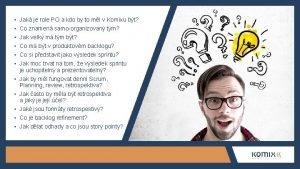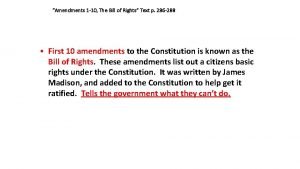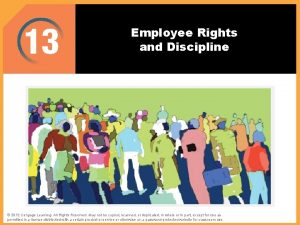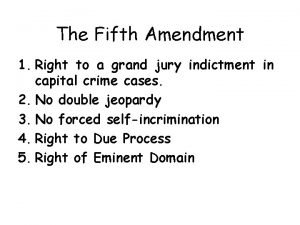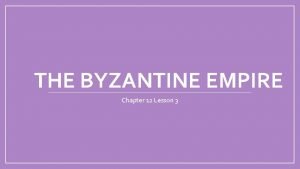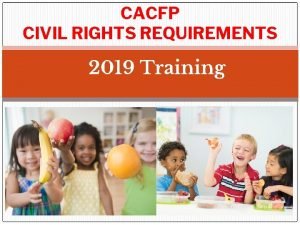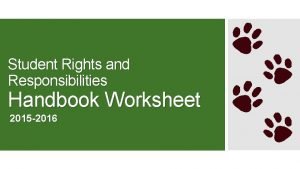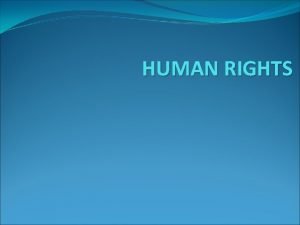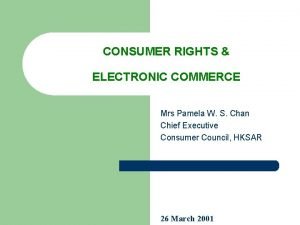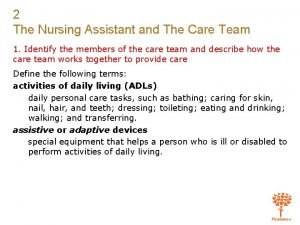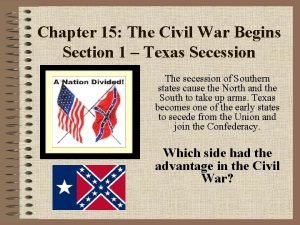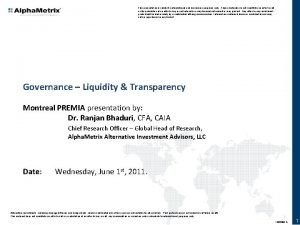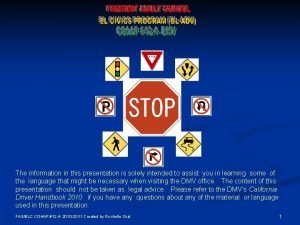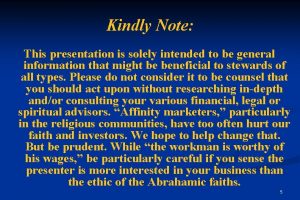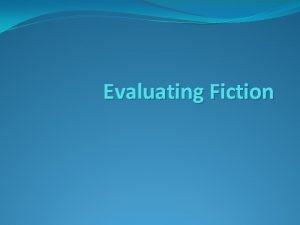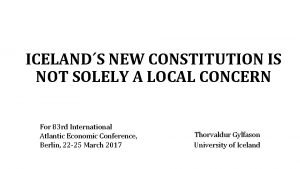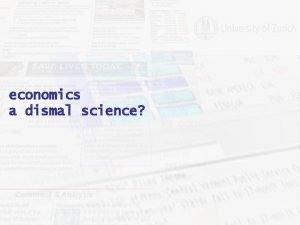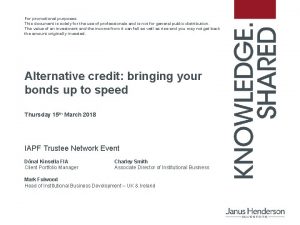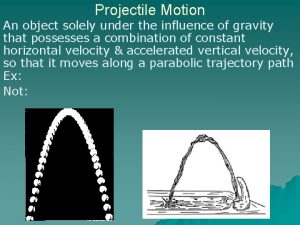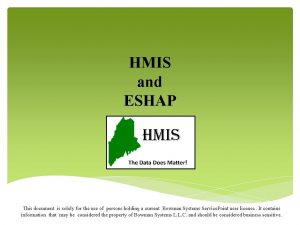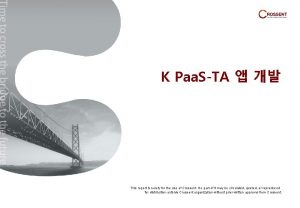Rights n n This presentation is solely for

































































































- Slides: 97

Rights n n This presentation is solely for use in summer 2001 CS 5704 at Virginia Tech. The sole right granted to each summer 2001 CS 5704 student is to print a single paper copy for use in this class. After producing a paper copy, students must remove this presentation from their computers and storage media. Students may not transfer any copy of this presentation to any third party. Each chart is copyrighted and must not be copied, reproduced, or otherwise used in any form without written permission of its copyright holder, Samuel T. Redwine, Jr. who reserves all rights. 11/9/2020 © 1997 -2001 Samuel T. Redwine, Jr. s. redwine@computer. org 1

CS 5704 Software Engineering Class 3 v. 6 n n n n n Introduction (7: 00 -7: 05) Review of Homework (7: 05 -7: 15) Framework for Software Engineering (7: 158: 25) Break (8: 25 -8: 35) Requirements and Architecture (8: 35 -9: 05) Reviews (9: 05 -9: 20) Questions about Third-term Exam (9: 20 -30) Discussion of how course has gone so far (9: 30 -9: 45) Conclusion (9: 45) 11/9/2020 © 1997 -2001 Samuel T. Redwine, Jr. s. redwine@computer. org 2

Introduction Do readings before do project work n Near end of class will discuss exam and class so far n 11/9/2020 © 1997 -2001 Samuel T. Redwine, Jr. s. redwine@computer. org 3

Scheme of Early Part of Course Identify needs 11/9/2020 Understand situation and alternative solutions Choose and justify to client a general alternative Detail and reach agreement with client on alternative’s behavior, structure, and development plan © 1997 -2001 Samuel T. Redwine, Jr. s. redwine@computer. org 4

Review of Homework Liked the listing of unanswered questions and activities to investigate/ mitigate risks n In doing needs and requirements, one thought per entry n From what you learned from the readings, what did you use in doing the project work? n 11/9/2020 © 1997 -2001 Samuel T. Redwine, Jr. s. redwine@computer. org 5

Framework for Software Engineering Representing, Engineering, Enacting, and Changing Enterprises (including Projects) or Systems, Composed of Arrangements of People, Hardware, Software, and Processes in Environments 11/9/2020 © 1997 -2001 Samuel T. Redwine, Jr. s. redwine@computer. org© 6

Overview n n n n Software Engineering Combines Several Fields Projects Involve Many Entities Doing The Purposes of Models Representations and Conceptual Bases Representing Computation and Organizations Commonalties 11/9/2020 © 1997 -2001 Samuel T. Redwine, Jr. s. redwine@computer. org 7

Software Engineering’s Location Management Systems Engineering Software Engineering Computer Science Organizational Studies 11/9/2020 © 1997 -2001 Samuel T. Redwine, Jr. s. redwine@computer. org 8

Software Engineer’s Location Application Area Systems Engineering Specialties 11/9/2020 Management Software Engineer Organizational Studies Interpersonal Relations Computer Science Professionalism © 1997 -2001 Samuel T. Redwine, Jr. s. redwine@computer. org 9

Project Entity. Relationship Goals Strive to meet Impact Evaluated against Output Guide Process Activities Products Descriptions Produce Input to “Actuals” Mitigate Supply & Supply Consume To execute impact require & use Impact performance Risks and Opportunities of 11/9/2020 Means Contribute to Supply Contexts © 1997 -2001 Samuel T. Redwine, Jr. s. redwine@computer. org 10

Examples n Human oriented • Need: Stay fed • Goal: Have meal to eat • Activity: Cook • Products: Ingredients, Plate & Meal • Means: Person(s), Utensils, Stove, Electricity • Processes: Recipes 11/9/2020 n Computer oriented • Need: Satisfy user • Goal: Meet postcondition • Activity: Run program • Means: Computing equipment & electricity • Process: Program © 1997 -2001 Samuel T. Redwine, Jr. s. redwine@computer. org 11

Project-Related Entities Inheritance Hierarchy n Foundation 11/9/2020 • • • Goals Activities Products • • • Means Contexts Processes (To be, are, have been) Risks and Opportunities Organizations – Tangibles – Intangibles © 1997 -2001 Samuel T. Redwine, Jr. s. redwine@computer. org 12

Activities n n Decide Produce Most “Lifecycle” engineering and many management activities go here • Produce Product • Produce Service n n n Take Action Measure Evaluate Communicate Document (for the record) 11/9/2020 n n n n CM QA Improve Process Improve people Train Purchase Overhead Milestone © 1997 -2001 Samuel T. Redwine, Jr. s. redwine@computer. org 13

Products n Tangibles • Externally Committed – Deliverable – Non-deliverable • Internally Committed – Deliverable – Non-deliverable n Intangibles • • Knowledge Skill Expectations Intentions • Status Reports • Messages 11/9/2020 © 1997 -2001 Samuel T. Redwine, Jr. s. redwine@computer. org 14

Means n Means required by activity • Roles (to be performed) • Aids (to be used but reusable afterwards) • Consumables (to be used up) Units of measure of amounts required and used also of interest 11/9/2020 © 1997 -2001 Samuel T. Redwine, Jr. n Fulfilling required means • Funds • Resources – Organizations • Anonymous • Identified – Persons • Anonymous • Identified – Automation • Software items • Hardware items – Products – Activities s. redwine@computer. org 15

Engineer and Do Plan Enact Generic and Alternative Process Descriptions Plan: Process Description for Future Process Instance History: Plan & Actual; Process Description of Past Process Instance Select, Instantiate, Modify, Compose 11/9/2020 © 1997 -2001 Samuel T. Redwine, Jr. s. redwine@computer. org 16

Processes n n n Futures Present (being enacted) [Just the change between Future and History? ] Histories 11/9/2020 n Timelines • Baselines • Variances n Some Attributes • • • Cost Schedule Quality Predictability Resources Results © 1997 -2001 Samuel T. Redwine, Jr. s. redwine@computer. org 17

Doing activities (manual or automated) is a central issue n In the next several charts, ignoring consumables -- for example, electricity and paper n Introduce the concept of “actor” n 11/9/2020 © 1997 -2001 Samuel T. Redwine, Jr. s. redwine@computer. org 18

Doing - 1 Existing Potentially (Re)Usable Items (Possibly Generic & Partial) Tools Other Stakeholders Kinds of means Doer/Actor/Agent Results: State and Items Tool, Item, & Process User Process for Doing Work 11/9/2020 © 1997 -2001 Samuel T. Redwine, Jr. s. redwine@computer. org 19

Doing - 2 Existing Potentially (Re)Usable Items (Possibly Generic & Partial) Tools Interaction Mechanisms Other Stakeholders Results: State and Items Doers/Actors/Agents Tool, Item, Interaction Mechanism, & Process Users Process for Doing Work 11/9/2020 © 1997 -2001 Samuel T. Redwine, Jr. s. redwine@computer. org 20

Supplier-Customer Chain Items Supplier Items Tool Supplier 11/9/2020 Results Process Supplier © 1997 -2001 Samuel T. Redwine, Jr. Results User s. redwine@computer. org 21

Supplier-Customer 11/9/2020 © 1997 -2001 Samuel T. Redwine, Jr. s. redwine@computer. org 22

Software Engineering Picture Representation of Reusable Software Processes Representation of Reusable Software Representation of Software Representation Software of Software Project Process Engineer Process Enacting Project Engineer Description: Plans & Actuals 11/9/2020 Other Stakeholders Executing Instance of Software Operational Users System Procedures © 1997 -2001 Samuel T. Redwine, Jr. s. redwine@computer. org 23

Summary Project-related entities include goals, process descriptions, activities, products, means, and risks n Actor does its process using available resources and tools in a larger environment with suppliers, customers, and other stakeholders n 11/9/2020 © 1997 -2001 Samuel T. Redwine, Jr. s. redwine@computer. org 24

Blackbox Can see only surface interface, not interior Interfacing dependably with a “blackbox” requires having not only a static representation of its interface but a representation that predicts its dynamic behavior. 11/9/2020 © 1997 -2001 Samuel T. Redwine, Jr. s. redwine@computer. org 25

Systems and Subsystems 1 2 3 11/9/2020 4 5 Overlap © 1997 -2001 Samuel T. Redwine, Jr. s. redwine@computer. org 26

World 11/9/2020 © 1997 -2001 Samuel T. Redwine, Jr. s. redwine@computer. org 27

Software Is in Larger Contexts n Software operates in a system which is embedded in larger systems Enterprise Hw Procedures Sw People 11/9/2020 © 1997 -2001 Samuel T. Redwine, Jr. s. redwine@computer. org 28

Agents/Actors Sensors Informational Agent Informational agent • Receives input from sensors Effectors • Provides output to effectors Agents may have internal state. 11/9/2020 © 1997 -2001 Samuel T. Redwine, Jr. s. redwine@computer. org 29

Four Variable Model Sensors Input Real World 11/9/2020 Computation Effectors Output Hardware Software © 1997 -2001 Samuel T. Redwine, Jr. s. redwine@computer. org 30

Relations Sensors Real E/S World Hardware Input I/O S/E Effectors 11/9/2020 S/I O/E Computation Output Software © 1997 -2001 Samuel T. Redwine, Jr. s. redwine@computer. org 31

Which Relation? Invisible Visible 11/9/2020 © 1997 -2001 Samuel T. Redwine, Jr. s. redwine@computer. org 32

Documentation Hw/Sw Statement of Situation Interface Sensors Real E/S World Needs Fulfilled S/E Effectors Hardware 11/9/2020 S/I Input System Requirements O/E I/O Computation Output Software Requirements Hw/Sw Interface Software © 1997 -2001 Samuel T. Redwine, Jr. s. redwine@computer. org 33

How Discuss Each of these relations describe dynamic behavior n Going to use I/O or Computational Unit as example to investigate them all n First discuss gradations of specification then characterizing a computational unit n 11/9/2020 © 1997 -2001 Samuel T. Redwine, Jr. s. redwine@computer. org 34

Remarks on Specifying Traditionally Say about Specifications n Continuity of Representations n Step-by-Step Refinement n Engineering Software Behavior n Formal Methods Aid Engineering n Specification Still Can Be Hard n Summary of Remarks on Specifying n 11/9/2020 © 1997 -2001 Samuel T. Redwine, Jr. s. redwine@computer. org 35

Remarks on Specifying n Forget traditional contrast between specifications and code and think of • Continuity of representations • Gradual step-by-step refinement Informal and formal methods aid the engineering of software behavior n Specification can be hard because need rich understanding of complex world n 11/9/2020 © 1997 -2001 Samuel T. Redwine, Jr. s. redwine@computer. org 36

Continuity of Representations n n Use series of representations from abstract specification to more concrete or executable No clear boundary between non-executable and executable representations All do the same thing, place constraints on software behavior Need to think of all these representations as the same kind of thing 11/9/2020 © 1997 -2001 Samuel T. Redwine, Jr. s. redwine@computer. org 37

Increasing Constraints on Computation Needs Code Design External Behavior Essential Requirements 11/9/2020 © 1997 -2001 Samuel T. Redwine, Jr. s. redwine@computer. org 38

Step-by-Step Refinement n n n Initial representation of software system generally abstract having only essential constraints As refine representation generally place tighter (stronger) constraints on resulting behavior If can show each refinement step results in constraints consistent with prior representation then end result consistent 11/9/2020 © 1997 -2001 Samuel T. Redwine, Jr. s. redwine@computer. org 39

Step-by-Step Refine Essential Requirements to Code Needs Code Design External Behavior Essential Requirements More about legitimate refinements later 11/9/2020 © 1997 -2001 Samuel T. Redwine, Jr. s. redwine@computer. org 40

Specification Still Can Be Hard n To Specify Must Have 11/9/2020 • Functionality: Understanding and prediction of environment/task • Reliability: Input distribution • Evolvability: Probabilities of kinds of future changes, their sequence, likelihood of occurring together, and constraints on doing • Safety: Hazards and accidents • Efficiency: Operational environment and nature of problem i. e. O (? ) • Security: Properties and threat characteristics • Probable Correctness: Way to measure © 1997 -2001 Samuel T. Redwine, Jr. s. redwine@computer. org 41

Summary Step from abstract and essential to concrete and executable n Refine so consistent with constraints n Specification is hard mainly for nontechnical reasons n 11/9/2020 © 1997 -2001 Samuel T. Redwine, Jr. s. redwine@computer. org 42

Fundamentals of Computation n. A Computational Unit as Black-Box n A Computational Unit in Some Environmental Scheme n Preconditions, Post-conditions, and Refinement n Composition of Multiple Units in Structured Arrangements 11/9/2020 © 1997 -2001 Samuel T. Redwine, Jr. s. redwine@computer. org 43

Black-Box External Behavior When does it execute? What is the result? Computational Unit What resources are used? 11/9/2020 Will result come out? What is duration? © 1997 -2001 Samuel T. Redwine, Jr. s. redwine@computer. org 44

Static Analysis of Black-Box External Behavior When might it execute? What might result? Computational Unit Might a result never come out? 11/9/2020 © 1997 -2001 Samuel T. Redwine, Jr. s. redwine@computer. org 45

Static Analysis of Black-Box External Behavior What might result? Might nothing result? When might it execute? One needs to characterize and calculate 11/9/2020 Computational Unit One needs to characterize and calculate © 1997 -2001 Samuel T. Redwine, Jr. s. redwine@computer. org 46

Static Analysis of Black-Box External Behavior What might result? Might nothing result? When might it execute? One needs to characterize and calculate Computational Unit One needs to characterize and calculate Formal Methods use mathematical representations and reasoning to accomplish these. Informal can aid. 11/9/2020 © 1997 -2001 Samuel T. Redwine, Jr. s. redwine@computer. org 47

When Executes n Occurrence (or potential occurrence) of execution of a computational unit requires two things to be true • Whatever scheme exists in the unit’s environment must allow unit to execute • Whatever self-contained scheme the unit has to allow/prevent its own execution must allow unit to execute 11/9/2020 © 1997 -2001 Samuel T. Redwine, Jr. s. redwine@computer. org 48

Internal Execute Prevent/Allow When environment allows execution, then guard allows/prevents execution. When execution allowed, what might result? Guard Computation 11/9/2020 © 1997 -2001 Samuel T. Redwine, Jr. s. redwine@computer. org 49

Internal Prevent/Allow of Execution When execution allowed, environment Results constrained to what might allows execution, only those results from result? then guard when allowed to execute allows/prevents execution. Guard Computation 11/9/2020 © 1997 -2001 Samuel T. Redwine, Jr. s. redwine@computer. org 50

Issues about Before and After Postcondition Precondition Computation Result Termination 11/9/2020 © 1997 -2001 Samuel T. Redwine, Jr. s. redwine@computer. org 51

Characterizing Computation After Before Domain 11/9/2020 Relationship Range © 1997 -2001 Samuel T. Redwine, Jr. s. redwine@computer. org 52

Refinement Precondition = Stand here 11/9/2020 © 1997 -2001 Samuel T. Redwine, Jr. s. redwine@computer. org Postcondition = hit target 53

Operations n Consider constraints and timing • Before/input values • After/output values Part of an operation’s constraints relate before/input and after/output values n Operation’s “Precondition and postcondition” n 11/9/2020 © 1997 -2001 Samuel T. Redwine, Jr. s. redwine@computer. org 54

What Need in Representations n Static representations that allow • • • Understanding of structure Specification of behavior Prediction of dynamic behavior – Internal – At interface 11/9/2020 © 1997 -2001 Samuel T. Redwine, Jr. s. redwine@computer. org 55

Predict Behavior Have representations of what it should and should not do at interfaces n Show that interior is such that it has n • Liveness properties: Will make progress toward what it should do • Safety properties: Will not ever do bad things • Timing is ok • Resource usage is acceptable 11/9/2020 © 1997 -2001 Samuel T. Redwine, Jr. s. redwine@computer. org 56

Structured Arrangements n Structures should allow calculation • When might execute • What might happen – Results – No results (termination is a result) 11/9/2020 © 1997 -2001 Samuel T. Redwine, Jr. s. redwine@computer. org 58

Structures for Composing Units Simple sequence n Invocation (same thread) n Alternatives (if. . fi) n G C Iteration (do. . od) G C n Recursion (not covered) n Concurrency (limited coverage) n 11/9/2020 © 1997 -2001 Samuel T. Redwine, Jr. s. redwine@computer. org 59

Pre/Post versus Forever So far we have modeled computation as having a start and a stop n Can also model as having a start but running forever n The forever model particularly good for concurrent systems and calculating their liveness and safety properties n 11/9/2020 © 1997 -2001 Samuel T. Redwine, Jr. s. redwine@computer. org 60

Representing What n Kinds of things or entities n Aspects n About the representations themselves • Existing • Doing/Changing 11/9/2020 • • Functionality - Non-Functionality Automation - Non-Automated Internals - Externals - Relationships Perspectives • • • Meaning Reasoning about Relationships among differing representations of/about same or related things © 1997 -2001 Samuel T. Redwine, Jr. s. redwine@computer. org 63

Artifact/Product Quality Criteria ity l i b a t s e t / y rifiabilit e V ecurity S cy a r u y c t c e f A a S F ty i l B i b T a M s / u y t i e l i R e c Reliab n a ty i l m i r b o f a n d o n a C t Unders Standards lerance ity l i b a v i v r o u T S Fault y c n y t e i i l i c i b f f a t e / p e a c d n A s s Performa e n ity c i l lete p p m i m s o / y C t lexi y t p i l i m b o a l i C a v A ility b a s U Portability d i l a V ility b a t n e y t i l m i e b l a p n i m I a t ain tion M a r g e t n i f r owe P Level o e fit p e o n c e S b / / t y t s i l o C s Genera s e n e v Competiti 11/9/2020 © 1997 -2001 Samuel T. Redwine, Jr. s. redwine@computer. org 64

Representational Relationships n Incrementally different • Derived • Inheritance n Across bases • Translation • Transformation n Interface • Two-way encapsulation: • Requirements and guarantees (Assumptions) • Implementation – Refinement • Abstract-Concrete • Less executable. More executable • Optimization 11/9/2020 © 1997 -2001 Samuel T. Redwine, Jr. s. redwine@computer. org 65

Representation and Represented n Too a fair extent, the same kinds of representations are used to represent the informational aspects of • • 11/9/2020 The user organization process The software engineering process Hardware/Software system Computation © 1997 -2001 Samuel T. Redwine, Jr. s. redwine@computer. org 66

Engineering Design Succeeds in Real World n Can be built n Problem solving n Dealing with people n Structuring artifacts n 11/9/2020 © 1997 -2001 Samuel T. Redwine, Jr. s. redwine@computer. org 67

Designer Formal Methods Actions n Represent n n Compose Abstract Refine Compare Prove n Use tools n n n 11/9/2020 © 1997 -2001 Samuel T. Redwine, Jr. s. redwine@computer. org 68

Summary n Software Engineer needs • A keen understanding of the environment, stakeholders, and future of the software • Knowledge of the known alternatives • Skill in software engineering methods • Creativity and problem solving skills • Interpersonal and conflict resolution skills • Comfort with a high rate of change and learning • Professionalism especially integrity and awareness of limitations • A well-developed aesthetic sense 11/9/2020 © 1997 -2001 Samuel T. Redwine, Jr. s. redwine@computer. org 69

Break and Meetings 10 Minute Left 11/9/2020 © 1997 -2001 Samuel T. Redwine, Jr. s. redwine@computer. org 70

Requirements and Architecture Hope understand specification better after first half n Architecture contains high-level and key structure and relationships, and constraints and stereotypes for all structure and relationships n 11/9/2020 © 1997 -2001 Samuel T. Redwine, Jr. s. redwine@computer. org 71

Purposes of Architecture Provide basis for detailed design, etc. n Allow intellectual mastery of full scope of system n Reflect most important concerns and properties n Typically, provide for or facilitate: reuse, evolution, integration, and dependability n 11/9/2020 © 1997 -2001 Samuel T. Redwine, Jr. s. redwine@computer. org 72

Analyze Requirements and Specify n n Social issues can dominate Separate but relate descriptions of • • • n n Problem or opportunity (need) Essential requirements of solutions (S/E & I/O) Solution Constructing(ed) Process is inevitably intertwined with design Tractability Validability Verifiability including testability 11/9/2020 © 1997 -2001 Samuel T. Redwine, Jr. s. redwine@computer. org 73

Customers and Users n Work closely with key customers • • • n n Involve all stakeholders as appropriate In internal development • • • n Advanced Typical Richest market Permanent liaisons with departments Involve users on development team Conflict resolution can be a key skill Consider participative development 11/9/2020 © 1997 -2001 Samuel T. Redwine, Jr. s. redwine@computer. org 74

Requirements n n Principles system follows: rules or schemes to be followed throughout Separately and uniquely recorded and identified -- current plus likely future changes Hierarchical span and modularity Group together • • n Cohesive functionality Separation of concerns Virtual machines Likely to change together Fit to situation (e. g. O-O, dataflow, and matrices all are best fits for different areas) 11/9/2020 © 1997 -2001 Samuel T. Redwine, Jr. s. redwine@computer. org 75

Choosing Notation and Abstraction deals with some things but not others n Designer chooses to describe some aspects but not others n Many levels of granularity n • From single statement • To entire system 11/9/2020 © 1997 -2001 Samuel T. Redwine, Jr. s. redwine@computer. org 79

Dataflow Source Dataflow Process Storage Sink 11/9/2020 © 1997 -2001 Samuel T. Redwine, Jr. s. redwine@computer. org 80

Psuedocode Use only three structured programming Structures n Some names may have no implementation n 11/9/2020 © 1997 -2001 Samuel T. Redwine, Jr. s. redwine@computer. org 81

Entity-Relationship For Real World or Data Car Ownership Person Relationship can be one-to-one, many-to-many 11/9/2020 © 1997 -2001 Samuel T. Redwine, Jr. s. redwine@computer. org 82

Object-Oriented Inheritance n Polymorphism n Method/Operation n Encapsulation n Has no state or does all interaction with its state n 11/9/2020 © 1997 -2001 Samuel T. Redwine, Jr. s. redwine@computer. org 83

Finite State Machines Initialization n Made up of • States • Transitions X – Usually Guarded – Sometimes modeled with side effects n n n Other representations often mapped to FSM for reachability analysis Some FSM allow transitions to same state A Safety Spec may forbid state(s) 11/9/2020 A K B Safety Spec N C M V © 1997 -2001 Samuel T. Redwine, Jr. s. redwine@computer. org Transition to same state R 84

Design - 1 n n Design for quality requirements/criteria Intellectual manageability • Architecture • Understandability • Analyzability n n Design by refinement Pre- and postconditions 11/9/2020 n Multiple • • n Alternatives Cycles Perspectives Stakeholders involved Use engineering principles © 1997 -2001 Samuel T. Redwine, Jr. s. redwine@computer. org 85

Design - 2 n Verifiability • • • n n Traceability Rigor Tractability Stimulate-ability Controllability Observability: interfaces & interior Assertions Built-in Measurement and Problem Reporting Built-in Test Fault Tolerance 11/9/2020 © 1997 -2001 Samuel T. Redwine, Jr. s. redwine@computer. org 86

Quality Often Architectural n n n Integration and dependability issues often must involve early, pervasive design decisions Integration, safety, security, fault tolerance, survivability, verifiability and analyzability can seldom if ever be achieved as afterthoughts or add-ons Adaptability, reusability, and easy evolution and upgrades often architectural 11/9/2020 © 1997 -2001 Samuel T. Redwine, Jr. s. redwine@computer. org 87

A Simple Model Context Overall Process Construct Activity Plan Establish Requirements Do Evaluate Improve Execute with Assessment & Fault Tolerance Customers Legal Means People Tools Infrastructure Reuse 11/9/2020 Users Competitors Labor Pool Investors Suppliers Standards Guidelines Available Suppliers Organization © 1997 -2001 Samuel T. Redwine, Jr. s. redwine@computer. org 88

Fault Tolerance Design Redundancy Process 1 Process 2 Vote Process 3 Test Process 2 Test Recovery Block N-Version Data Redundancy 11/9/2020 Process 1 Process 3 Compare © 1997 -2001 Samuel T. Redwine, Jr. s. redwine@computer. org 89

Design Summary n n n Quality planned Quality of designers Design process - feedback to requirements, multiple alternatives Architecture Design methods and representations Features included for • Verifiability • Built-in – Measurement – Problem reporting – Fault tolerance 11/9/2020 © 1997 -2001 Samuel T. Redwine, Jr. s. redwine@computer. org 90

Code Rigorous specifications n Use Style Guide n Refinement/proofing n Review before test n 11/9/2020 © 1997 -2001 Samuel T. Redwine, Jr. s. redwine@computer. org 91

Prototype n Establish • • Goals/objectives Questions to be answered Metrics to be used to answer questions Prototyping approach Develop prototype n Evaluate prototype n Report on prototype n Place (re)usable results under CM Most common problem is throwaway prototype not sticking to just answering questions. 2 nd is inexcusable engineering. n 11/9/2020 © 1997 -2001 Samuel T. Redwine, Jr. s. redwine@computer. org 92

Reviews When Might Review n Peer Reviews n 11/9/2020 © 1997 -2001 Samuel T. Redwine, Jr. s. redwine@computer. org 93

Activity-Artifact Evaluations Potential Time for Artifact Evaluation Potentially also Process Evaluations Intermediate Activity Evaluate Input 11/9/2020 Evaluate Activity Readiness Proposed Final © 1997 -2001 Samuel T. Redwine, Jr. s. redwine@computer. org 94

Peer Reviews Purposes n Process n Varieties n 11/9/2020 © 1997 -2001 Samuel T. Redwine, Jr. s. redwine@computer. org 95

Purposes of Peer Reviews Finding faults or opportunities for improvement n Verification n Validation n Professional development n 11/9/2020 © 1997 -2001 Samuel T. Redwine, Jr. s. redwine@computer. org 96

Peer Review Process n Organization • Policy and procedures • Project plans – Occurrence – Participants • Moderator training • Staff training • Process auditing & enforcement 11/9/2020 n Each review • • • Plan Prepare for review Review Follow-up Report Repeat as needed © 1997 -2001 Samuel T. Redwine, Jr. s. redwine@computer. org 97

Variety of Peer Reviews Traditional reviews n Inspections n Distributed processes n May or may not have n • • • 11/9/2020 Meeting Moderator Official quality report Quality “grade” Formal methods basis (e. g. Cleanroom) Automated support © 1997 -2001 Samuel T. Redwine, Jr. s. redwine@computer. org 98

Summary Stakeholders and real world help determine requirements and expected quality n One of many ways to evaluate quality is a peer review n 11/9/2020 © 1997 -2001 Samuel T. Redwine, Jr. s. redwine@computer. org 99

Many Factors Effect Quality Requirements n Construction process n Means used in construction n Operational fault tolerance and support n Expectations and perceptions n 11/9/2020 © 1997 -2001 Samuel T. Redwine, Jr. s. redwine@computer. org 100

Discussion n So far in course • What was good? • What could be better? 11/9/2020 © 1997 -2001 Samuel T. Redwine, Jr. s. redwine@computer. org 101

Deliverables Due Next Class n n n Needs list Draft Features list Draft List of Components n Traceability between n Optional: Storyboards, Prototype, E-R diagram • For each component list of tasks to produce it 11/9/2020 • Needs and features • Features and components © 1997 -2001 Samuel T. Redwine, Jr. s. redwine@computer. org 102

Conclusion Similar models can describe informational behaviors of software process engineer, software engineer, computation, and user n Four Variable Model helps clarify relationships n Use the notation that is best for you n Redwine’s Software Engineering Guide Service A Fall Learning Experience 11/9/2020 © 1997 -2001 Samuel T. Redwine, Jr. s. redwine@computer. org 103
 The sprint backlog belongs solely to the
The sprint backlog belongs solely to the Disclaimer
Disclaimer Negative right
Negative right Positive vs negative rights
Positive vs negative rights Positive and negative rights
Positive and negative rights Riparian or littoral rights
Riparian or littoral rights Negative rights
Negative rights Conclusion of rights
Conclusion of rights Negative right
Negative right Legal rights vs moral rights
Legal rights vs moral rights Tidböcker
Tidböcker Handledning reflektionsmodellen
Handledning reflektionsmodellen Vilken grundregel finns det för tronföljden i sverige?
Vilken grundregel finns det för tronföljden i sverige? Bamse för de yngsta
Bamse för de yngsta Verktyg för automatisering av utbetalningar
Verktyg för automatisering av utbetalningar Kanaans land
Kanaans land Kolposkopi, px
Kolposkopi, px Jag har nigit för nymånens skära
Jag har nigit för nymånens skära Boverket ka
Boverket ka Strategi för svensk viltförvaltning
Strategi för svensk viltförvaltning Ro i rom pax
Ro i rom pax Vad är verksamhetsanalys
Vad är verksamhetsanalys Matematisk modellering eksempel
Matematisk modellering eksempel Tack för att ni har lyssnat
Tack för att ni har lyssnat Läkarutlåtande för livränta
Läkarutlåtande för livränta Texter för hinduer tantra
Texter för hinduer tantra Ekologiskt fotavtryck
Ekologiskt fotavtryck Centrum för kunskap och säkerhet
Centrum för kunskap och säkerhet Inköpsprocessen steg för steg
Inköpsprocessen steg för steg Påbyggnader för flakfordon
Påbyggnader för flakfordon Sura för anatom
Sura för anatom Egg för emanuel
Egg för emanuel Fr formel
Fr formel Rutin för avvikelsehantering
Rutin för avvikelsehantering Presentera för publik crossboss
Presentera för publik crossboss Formuö
Formuö Treserva lathund
Treserva lathund Myndigheten för delaktighet
Myndigheten för delaktighet Mall för debattartikel
Mall för debattartikel Tack för att ni lyssnade
Tack för att ni lyssnade En lathund för arbete med kontinuitetshantering
En lathund för arbete med kontinuitetshantering Tobinskatten för och nackdelar
Tobinskatten för och nackdelar Vad är referatmarkeringar
Vad är referatmarkeringar Tack för att ni har lyssnat
Tack för att ni har lyssnat Byggprocessen steg för steg
Byggprocessen steg för steg Karttecken punkthöjd
Karttecken punkthöjd Meios steg för steg
Meios steg för steg Shingelfrisyren
Shingelfrisyren Fuktmätningar i betong enlig rbk
Fuktmätningar i betong enlig rbk Lufttryck formel
Lufttryck formel Var 1721 för stormaktssverige
Var 1721 för stormaktssverige Vad är densitet
Vad är densitet Elektronik för barn
Elektronik för barn Tack för att ni har lyssnat
Tack för att ni har lyssnat Smärtskolan kunskap för livet
Smärtskolan kunskap för livet Typiska novell drag
Typiska novell drag Luftstrupen för medicinare
Luftstrupen för medicinare Frgar
Frgar Autokratiskt ledarskap
Autokratiskt ledarskap Mindre än tecken
Mindre än tecken Särskild löneskatt för pensionskostnader
Särskild löneskatt för pensionskostnader Toppslätskivling effekt
Toppslätskivling effekt Redogör för vad psykologi är
Redogör för vad psykologi är Borra hål för knoppar
Borra hål för knoppar Mat för idrottare
Mat för idrottare Bris för vuxna
Bris för vuxna Teckenspråk minoritetsspråk argument
Teckenspråk minoritetsspråk argument Etik och ledarskap etisk kod för chefer
Etik och ledarskap etisk kod för chefer Svenskt ramverk för digital samverkan
Svenskt ramverk för digital samverkan Vad kallas den mantel som bars av kvinnor i antikens rom
Vad kallas den mantel som bars av kvinnor i antikens rom Ellika andolf
Ellika andolf Datorkunskap för nybörjare
Datorkunskap för nybörjare Steg för steg rita
Steg för steg rita Ministerstyre för och nackdelar
Ministerstyre för och nackdelar Tillitsbaserad ledning
Tillitsbaserad ledning Lek med geometriska former
Lek med geometriska former Tack för att ni lyssnade bild
Tack för att ni lyssnade bild Claes martinsson
Claes martinsson Dikt på rim
Dikt på rim Nyckelkompetenser för livslångt lärande
Nyckelkompetenser för livslångt lärande Occipital brow presentation
Occipital brow presentation Cephalic presentation
Cephalic presentation Projects abroad human rights office
Projects abroad human rights office Title vii of the civil rights act
Title vii of the civil rights act Amendments 1-10
Amendments 1-10 Ethics and employee rights and discipline
Ethics and employee rights and discipline Property rights amendment
Property rights amendment Byzantine empire
Byzantine empire Cacfp civil rights
Cacfp civil rights Rights and responsibilities worksheet
Rights and responsibilities worksheet Human rights history
Human rights history Nonmail
Nonmail Basic consumer rights
Basic consumer rights The nursing assistant and the care team chapter 2
The nursing assistant and the care team chapter 2 Rights of trade unions
Rights of trade unions Family educational rights and privacy act of 1974
Family educational rights and privacy act of 1974 States rights
States rights Copyright © 2018 all rights reserved
Copyright © 2018 all rights reserved
